IASbaba's Daily Current Affairs Analysis
Archives
(PRELIMS & MAINS Focus)
Syllabus
- Prelims – Governance
Context: The Monument Mitra scheme, which entails adopting a heritage site and maintaining it, will soon be revamped to enable private firms, to partner for the upkeep of 1,000 ASI monuments.
About Monument Mitra Project:
- It aims at ensuring quality and inclusive provision of amenities and facilities across heritage, natural, and tourist sites through active participation of private and public sector organizations and individuals.
- These organizations would be known as “Monument Mitras” for their collaboration initiative.
- This project is envisioned to fulfill the objective of the Government of India to provide an enhanced tourism experience to all travelers.
- The project plans to entrust development, upgradation and maintenance of amenities and facilities at the heritage, natural and tourist sites to the Monument Mitras, coupled with innovation and technology interventions to increase awareness of these incredible treasures.
- The project began with 93 ASI monuments and has extended to heritage, natural and tourist sites across India.
- This revised scheme will be led by the culture ministry.
- The previous scheme was led by the tourism ministry.
- The monuments are separated into three categories depending on tourist footfall and visibility:
- Green:
- Iconic sites like the Taj Mahal, Qutub Minar, and Red Fort, among others, are categorized as ‘Green’.
- Blue:
- while Purana Quila and Jantar Mantar fall in the ‘Blue’ category.
- Orange:
- The Sanchi Stupa is one popular site in the ‘Orange’ category.
- Entities are encouraged to adopt from the Blue and Orange category, or a mix of the three.
- Adoption of only ‘Green’ category monuments is not allowed.
Source: The Hindu
Previous Year Questions
Q.1) Consider the following pairs:
Site of Ashoka’s major rock edicts Location in the State of
- Dhauli Odisha
- Erragudi Andhra Pradesh
- Jaugada Madhya Pradesh
- Kalsi Karnataka
How many pairs given above are correctly matched? (2022)
- Only one pair
- Only two pairs
- Only three pairs
- All four pairs
Q.2) Consider the following pairs:
Historical place Well-known for
- Burzahom Rock-cut shrines
- Chandraketugarh Terracotta art
- Ganeshwar Copper artefacts
Which of the pairs given above is/are correctly matched? (2021)
- 1 only
- 1 and 2
- 3 only
- 2 and 3
Syllabus
- Prelims – Economy
Context: After China, India will become the second country in the world to start the ‘trade-plus-one’ (T+1) settlement cycle in top listed securities today (January 27), bringing operational efficiency, faster fund remittances, share delivery, and ease for stock market participants.
About the T+1 Settlement Cycle:
- The T+1 settlement cycle means that trade-related settlements must be done within a day, or 24 hours, of the completion of a transaction.
- Until 2001, stock markets had a weekly settlement system.
- The markets then moved to a rolling settlement system of T+3, and then to T+2 in 2003.
- The United States, United Kingdom and Eurozone markets are yet to move to the T+1 system.
Significance of T+1 plan:
- In the T+1 format, if an investor sells a share, he/she will get the money within a day, and the buyer will get the shares in his/her Demat account also within a day.
- This will also help investors in reducing the overall capital requirements with the margins getting released on T+1 day, and in getting the funds in the bank account within 24 hours of the sale of shares.
- The shift will boost operational efficiency as the rolling of funds and stocks will be faster.
Source: Indian Express
Previous Year Questions
Q.1) With reference to Non-Fungible Tokens (NFTs), consider the following statements:
- They enable the digital representation of physical assets.
- They are unique cryptographic tokens that exist on a blockchain.
- They can be traded or exchanged at equivalency and therefore can be used as a medium of commercial transactions.
Which of the statements given above are correct? (2022)
- 1 and 2 only
- 2 and 3 only
- 1 and 3 only
- 1, 2 and 3
Q.2) With reference to India, consider the following statements:
- Retail investors through Demat account can invest in Treasury Bills and Government of India Debt Bonds in the primary market
- The “Negotiated Dealing System-Ordering Matching” is a government securities trading platform of the Reserve Bank of India.
- The “Central Depository Services Ltd” is jointly promoted by the Reserve Bank of India and the Bombay Stock Exchange.
Which of the statements given above is/are correct? (2021)
- 1 only
- 1 and 2
- 3 only
- 2 and 3
Syllabus
- Prelims – Geography and Economy
Context: Considering the increase in the cultivation of millets, the Centre may soon announce a benchmark price for minor millets produced in various States. The Centre said it would help States to procure and distribute millets through the public distribution system.
- At present, millets such as jowar, bajra and ragi are procured by nine States with the minimum support price announced by the Centre.
- Minor millets are not procured at the moment.
About Minor Millets:
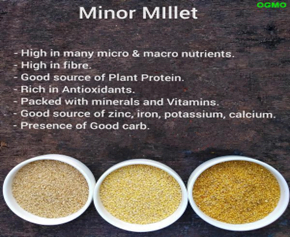
- The minor millets comprise of proso millet (Panicum miliaceum), foxtail millet or (Setariaitalica), little millet (Panicum sumatrense), barnyard millet (Echinochloa colona) and Kodo millet (Paspalum scrobiculatum).
- Minor millets are high energy, nutritious foods comparable to other cereals and some of them are even better with regard to protein and mineral content.
- They are particularly low in phytic acid and rich in dietary fibre, iron, calcium and B vitamins.
- With proper preparation, 30 per cent of minor millets can be gainfully substituted in value added foods belonging to the categories of traditional foods, bakery products, extruded foods and allied mixes for the convenient preparation by rural and town folk at low cost.
- Poroso millet flour is used as a substitute for rice flour in various snack foods.
- Traditionally, finger, Kodo and Poroso millets are brewed by tribal in certain parts of India.
- Popping of finger millet is done on cottage industry level and the popped meal is marketed in polyethylene pouches.
Source: The Hindu
Previous Year Question
Q.1) Among the following, which one is the least water-efficient crop? (2021)
- Sugarcane
- Sunflower
- Pearl millet
- Red gram
Syllabus
- Prelims – Economy
Context: The Securities and Exchange Board of India (SEBI) will challenge the order of the Securities Appellate Tribunal (SAT), which set aside Rs 624 crore disgorgement order against the National Stock Exchange (NSE) by the market regulator in the co-location scam.
Meaning of Co-location:

- Co-location is a data centre facility where third parties can lease space for servers and other computer hardware.
- They provide infrastructure like power supply, bandwidth and cooling for setting up servers and storage of data.
- Customers usually rent out space by rack, cabinet, cage or room.
About the NSE co-location case:
- The NSE introduced co-location facilities in 2009 and offered traders/brokers the ability to place their servers within NSE’s data centre for a fee.
- By being in close proximity to the stock exchange servers, traders/brokers would have faster access to the price feed and the execution of trades, due to the low latency connectivity.
- In January 2015, a whistle-blower wrote a complaint to SEBI, alleging that some brokers who leased space at the NSE co-location facility, were able to log into the NSE systems with better hardware specifications while engaging in algorithmic trading.
- This allowed them unfair access from the period 2012-2014, as the hardware specifications gave them a split-second advantage in accessing the price feed.
- A minuscule difference in time can lead to huge gains for a trader.
- At that time NSE used to disseminate information through unicast, which is a single, direct request sent from one host to another, with only those hosts interacting over the route.
- At least 15 brokers were identified by SEBI for having preferential access.
MUST READ: About SEBI
MUST READ: National Stock Exchange
Source: Indian Express
Previous Year Question
Q.1) With reference to the Indian economy, demand-pull inflation can be caused/increased by which of the following? (2021)
- Expansionary policies
- Fiscal stimulus
- Inflation-indexing wages
- Higher purchasing power
- Rising interest rates
Select the correct answer using the code given below.
- 1, 2 and 4 only
- 3, 4 and 5 only
- 1, 2, 3 and 5 only
- 1, 2, 3, 4 and 5
Syllabus
- Prelims – Governance
In News: In line with the vision of celebrating our glorious tribal heritage, a tableau by the Ministry of Tribal Affairs showcasing tribal welfare through quality education in Eklavya Model Residential Schools established for ST children across the country featured at the national Republic Day Parade.
Eklavya Model Residential School (EMRS) scheme
- EMRS started in the year 1997-98
- It is one of the flagship interventions of the Ministry of Tribal Affair
- The schools focus not only on academic education but on the all-round development of the students.
- Each school has a capacity of 480 students, catering to students from Class VI to XII.
- Hitherto, grants were given for construction of schools and recurring expenses to the State Governments under Grants under Article 275 (1) of the Constitution.
- In order to give further impetus to EMRS, it has been decided that by the year 2022, every block with more than 50% ST population and at least 20,000 tribal persons, will have an EMRS.
- Eklavya schools will be on par with Navodaya Vidyalaya and will have special facilities for preserving local art and culture besides providing training in sports and skill development.
- Across the country, as per census 2011 figures, there are 564 such sub-districts out of which there is an EMRS in 102 sub-districts. Thus, 462 new schools have to be opened by the year 2022.
Eklavya Model Day Boarding Schools (EMDBS)
- Wherever density of ST population is higher in identified Sub-Districts (90% or more), it is proposed to set up Eklavya Model Day Boarding School (EMDBS) on an experimental basis for providing additional scope for ST Students seeking to avail school education without residential facility.
Centre of Excellence for Sports (CoE for Sports)
- Dedicated infrastructure for setting up Centre of Excellence for sports with all related infrastructure (buildings, equipment’s etc.) is supported.
- This Centre of Excellence will have specialized state-of-the-art facilities for one identified individual sport and one group sport in each State.
Source PIB
Syllabus
- Prelims – Geography
In News: In Lakshadweep, pomp and gaiety marked the Republic Day celebrations in the ten inhabited islands in the archipelago, where people participated in large numbers.
Lakshadweep Islands

- India’s smallest Union Territory Lakshadweep is an archipelago consisting of 36 islands with an area of 32 sq km
- It is known for its exotic and sun-kissed beaches and lush green landscape.
- The name Lakshadweep in Malayalam and Sanskrit means ‘a hundred thousand islands’.
- It is a uni-district Union Territory and the islands were constituted a union territory in 1956.
- It comprises of 12 atolls, three reefs, five submerged banks and ten inhabited islands.
- The principal islands in the territory are Minicoy and those in the Amindivi group.
- The easternmost island lies about 185 miles (300 km) from the coast of the state of Kerala. Ten of the islands are inhabited.
- Capital – Kavaratti
- Aside from an abundance of coconut palms, common trees include banyans, casuarinas, pandani (screw pines), breadfruits, tamarinds, and tropical almonds (genus Terminalia). Betel nut and betel leaf also grow in the islands.
- Among the most notable marine fauna are sharks, bonitos, tunas, snappers, and flying fish. Manta rays, octopuses, crabs, turtles, and assorted gastropods are plentiful. The islands also are home to an array of water birds, such as herons, teals, and gulls.
Climate
- Lakshadweep has a tropical climate and it has an average temperature of 27° C – 32° C.
- April and May are the hottest. Generally the climate is humid warm and pleasant.
- October to March is the ideal time to be on the islands.
- From June to October the South West Monsoon is active with an average rainfall of 10-40 mm.
- Winds are light to moderate from October to March.
Fauna & Flora
- Includes Banana, Vazha,(Musaparadisiaca), Colocassia, Chambu (Colocassia antiquarum) Drumstic moringakkai, wild almond
- Shrubs – Kanni, Punna, Chavok, Cheerani
- Coconut, Thenga – only crop of economic importance in Lakshadweep.
- Sea grass – Thalassia hemprichin and Cymodocea isoetifolia. They prevent sea erosion and movement of the beach sediments.
- The commonly seen vertebrates are cattle and poultry.
- Oceanic birds – Tharathasi and Karifetu (Anous solidus).
- Molluscan forms are also important from the economic point of the islands.
Culture & Heritage


- Kolkali and Parichakali are the two popular folk art forms in the Territory.
- They are an integral part of the cultural milieu except in Minicoy where “LAVA” is the most popular dance form.
- Some of the folk dances have a resemblance with those in North Eastern India.
- For marriages “OPPANA” is a common feature, a song sung by a lead singer and followed by a group of women.
Demography
- As per details from Census 2011, Lakshadweep has population of 64 Thousands of which male and female are 33,123 and 31,350 respectively
- The total population growth in this decade was 6.30 percent while in previous decade it was 17.19 percent.
Sources: Newsonair
Previous Year Question
Q1) Consider the following statements: (2018)
- The Barren Island volcano is an active volcano located in the Indian territory.
- Barren Island lies about 140 km east of Great Nicobar.
- The last time the Barren Island volcano erupted was in 1991 and it has remained inactive since then.
Which of the statements given above is/are correct?
- 1 only
- 2 and 3
- 3 only
- 1 and 3
Syllabus
- Prelims – Environment
In News: Similipal National Park has turned out to be the hunting ground for animal poachers over the last few years.
- Most recently, the carcass of a male elephant was found in the Talabandha wildlife range
Simplipal National Park
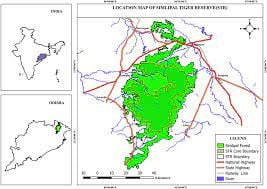
- Located in northern part of Odisha’s Mayurbhanj district
- Similipal derives its name from ‘Simul’ (Silk Cotton) tree
- It is a national park and a Tiger Reserve
- The tiger reserve is spread over 2750 sq km and has some beautiful waterfalls like Joranda and Barehipani.
- The park is surrounded by high plateaus and hills, the highest peak being the twin peaks of Khairiburu and Meghashini (1515m above mean sea level).
- At least twelve rivers cut across the plain area, all of which drain into the Bay of Bengal – Burhabalanga, Palpala Bandan, Salandi, Kahairi and Deo.
- Prominent tribes – Kolha, Santhala, Bhumija, Bhatudi, Gondas, Khadia, Mankadia and Sahara.
- The vegetation is a mix of deciduous with some semi-evergreen forests
- Sal is the dominant tree species
Biodiversity in the park:
- An astounding 1078 species of plants including 94 species of orchids find their home in the park.
- These forests boast of many plants that have medicinal and aromatic properties.
- The park is known for the tiger, elephant and hill mynah.
- It holds the highest tiger population in the state of Odisha.
- Apart from the tiger, the major mammals are leopard, sambar, barking deer, gaur, jungle cat, wild boar, four-horned antelope, giant squirrel and common langur.
- Grey hornbill, Indian pied hornbill and Malabar pied hornbill are also found here.
- The park also has a sizeable population of reptiles, which includes the longest venomous snake, the King cobra and the Tricarinate hill turtle.
- The Mugger Management Programme at Ramatirtha has helped the mugger crocodile to flourish on the banks of the Khairi and Deo Rivers
- Similipal has turned out to be the haven for hunters and poachers as the region has witnessed several killings of elephants, tigers and leopards
Threats:
- About 20 adult breeding male elephants die each year, mostly to unnatural causes like poaching and electrocution.
- The dwindling breeding male population and the isolated populations due to fragmented forests is weakening the gene pool due to mating among immature individuals and inbreeding.
- There is a link between poaching and trading of elephant tusks, tiger skins and leopard skins since these fetch a huge price in the international market despite the global ban
- Even though Elephants are protected under Schedule 1 of the Wildlife Protection Act, 1972, there is a rise in poaching cases
- While tiger population has gone up in most Indian states, in Odisha it has come down or remained static
Source: DTE
Previous Year Question
Q1) With reference to India’s Desert National Park, which of the following statements are correct? (2020)
- It is spread over two districts.
- There is no human habitation inside the Park.
- It is one of the natural habitats of Great Indian Bustard.
Select the correct answer using the code given below:
- 1 and 2 only
- 2 and 3 only
- 1 and 3 only
- 1, 2 and 3
Syllabus
- Prelims – Environment
In News: Kelp forests are declining because of climate change as per the study published in the journal Nature 2023
- Kelp populations at equatorward-range edges are particularly vulnerable to climate change as these locations are undergoing warming at or beyond thermal tolerance thresholds
Kelp forests
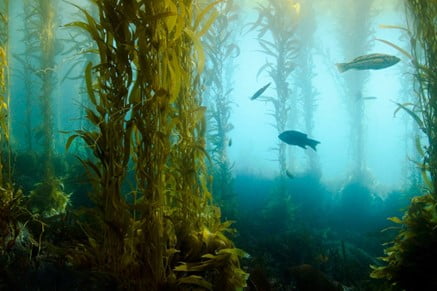
- Kelp are large brown algae
- These are underwater ecosystems found in cool, nutrient rich, shallow waters that are close to the shore
- Many organisms use the thick blades as a safe shelter for their young from predators or even rough storms.
- Some kelp species can measure up to 150 feet (45 m) long. If living in ideal physical conditions, kelp can grow 18 inches (45 cm) a day.
- Sea urchins can destroy entire kelp forests at a rate of 30 feet (9 m) per month by moving in herds. Sea otters play a key role in stabilizing sea urchin populations so that kelp forests may thrive.
- Ecklonia radiata is the dominant and most widely distributed Laminarian kelp in the southern hemisphere
- New populations were found in shallower and cooler winter months with temperatures around 20°C
- Kelp can sometimes persist at lower latitudes, aided by cool water upwelling or in deep-water refugia where they are protected by thermocline (the transition layer between the warmer mixed water at the surface and the cooler deep water below)
Significance:
- Kelp forests provide food and shelter for thousands of species such as seals, sea lions, whales, sea otters, gulls, terns, snowy egrets, great blue herons, cormorants, and shore birds.
- Kelp forests provide underwater habitats to hundreds of species of invertebrates, fishes, and other algae and have great ecological and economic value.
- Loss of kelp forests will also lead to a decline of the unique biodiversity that they support
- There is high evolutionary diversity in the low-latitudes as many marine organisms were only able to persist within ice-free refuge areas at lower latitudes during the Ice Age
- Giant kelp is harvested from kelp forests and used as a binding agent in products like ice cream, cereal, ranch dressing, yogurt, toothpaste, lotion and more.
Threats
- The unique adaptive or evolutionary genetic diversity that the rear-edge populations (populations in warm, low-latitudes) may contain is also under threat due to rapid warming
Source DTE
Previous Year Question
Q1) Consider the following statements: (2018)
- Most of the world’s coral reefs are in tropical waters.
- More than one-third of the world’s coral reefs are located in the territories of Australia, Indonesia and Philippines.
- Coral reefs host far more number of animal phyla than those hosted by tropical rainforests.
Which of the statements given above is/are correct?
- 1 and 2 only
- 3 only
- 1 and 3 only
- 1, 2 and 3
Syllabus
- Mains – GS 2 (Governance) and GS 3 (Economy)
Context: Recently, the Union Ministry of Commerce and Industry, Consumer Affairs, Food and Public Distribution and Textiles held the fourth Plenary Session of B20 India Inception Meeting on Building Resilient Global Value Chains in Gandhinagar, Gujrat.
About MSMEs:
- MSMEs or Micro, Small, and Medium Enterprises are businesses that are defined by their investment and turnover levels. They are considered an important sector of the economy as they create jobs, generate income, and promote entrepreneurship.
Classification of MSMEs:
- Based on their Investment and turnover levels:
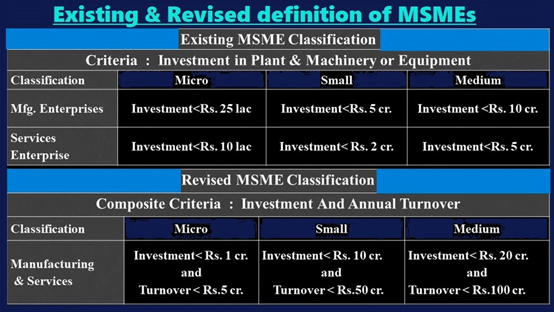
- Based on the nature of activities and sectors
- Manufacturing Enterprise: Manufacturing of goods pertaining to any industry specified in the first schedule of the industries (Development and Regulation) Act, 1951
- Service Enterprise: Providing or rendering of services and covered under ‘Services’ sector as defined in the Micro, Small and Medium Enterprises Development (MSMED) Act, 2006.
Advantages of MSMEs: MSMEs play a crucial role in the global value chain and their support and integration is vital for a resilient global supply chain.
- MSMEs flourish around a larger unit or anchor, an example given is that when a large company such as Apple sets up a manufacturing plant, thousands of MSME units flourish in the ecosystem as mini value chain suppliers to Apple.
- Diversification: MSMEs can help diversify an economy by creating new industries and markets.
- Regional development: These are often based in specific regions, which can promote development in those areas.
- Flexibility: MSMEs have more flexibility than larger companies in terms of decision-making and the ability to pivot their business models.
- Economic development: They play a crucial role in the economic development of a country by providing goods and services, generating income, and creating opportunities for people to improve their standard of living.
- Innovation: These are often more adaptable and innovative than larger companies, which can lead to new products, processes, and business models.
- Reduced risk: MSMEs typically have lower startup costs and are less risky investments than larger companies.
- Lower regulatory burden: MSMEs typically have to navigate fewer regulations than larger companies, making it easier for them to start and operate their business.
- Easier access to credit: They have easier access to credit than larger companies.
Issues associated with the MSMEs:
- Lack of skilled labour: MSMEs often struggle to find skilled workers, which can make it difficult for them to grow and expand their businesses.
- Bureaucratic red tape: MSMEs have to navigate a complex web of regulations and bureaucratic procedures, which can be time-consuming and costly.
- Competition from larger companies: MSMEs in India often have to compete with larger, more established companies, which can make it difficult for them to succeed in the market.
- Access to finance: MSMEs often struggles to access capital due to a lack of collateral or credit history or access to formal financial institutions.
- Lack of infrastructure: MSMEs often lack access to basic infrastructure, such as electricity and transportation, which can make it difficult for them to operate their businesses.
- Lack of technological know-how: MSMEs often lack the technical knowledge and expertise to modernize their operations and stay competitive in the market.
- Issues with supply chain and logistics: MSMEs face issues with supply chain and logistics, which can make it difficult for them to get their products to market in a timely and cost-effective manner.
- Lack of formalization: Many MSMEs in India are unregistered or operate informally, which can make it difficult for them to access government support and benefits.
- Lack of marketing and networking opportunities: MSMEs in India often lack the resources and networks to effectively market their products and services, which can make it difficult for them to reach new customers and grow their businesses.
Government of India Initiatives for strengthening MSMEs:
- Comprehensive Economic Partnership Agreement (CEPA): It will help MSMEs of both India and UAE to leverage benefits of the District as export hub initiative of the government.
- Harmonizing value chain: Government to focus on integrating India’s value chains with the rest of the world and creating logistics that are easier and faster is crucial to make it easier for international companies to include India in their value chains.
- Quality assurance: Government to focus on creating Quality as the most important factor in the success story of India through steps including- setting global benchmarks, harmonizing Indian standards with global standards, and consumers becoming more demanding of quality.
- Under this initiative, every district for their unique products and identify the specialty of districts by knowing which district exports which products.
- This initiative is expected to help in promoting local products and in turn, boost the local economy.
- Pradhan Mantri MUDRA Yojana (PMMY)
- Prime Minister’s Employment Generation Programme (PMEGP)
- Stand Up India: The scheme provides financial assistance to scheduled caste (SC), scheduled tribe (ST) and women entrepreneurs for setting up new enterprises.
- Credit Guarantee Fund Trust for Micro and Small Enterprises (CGTMSE): This scheme provides collateral-free credit to micro and small enterprises through a credit guarantee mechanism.
Way Forward:
- Infrastructure development: Improving infrastructure in areas where MSMEs are concentrated, such as by building roads, providing electricity and water supply, and improving transportation.
- Access to finance: The government can work to improve access to finance for MSMEs by providing credit guarantees, offering tax incentives for lending to MSMEs, and encouraging banks and other financial institutions to lend to MSMEs.
- Simplifying regulations: The government can simplify regulations and procedures for MSMEs, such as by streamlining registration and compliance processes and reducing the bureaucratic burden on MSMEs.
- Skilled labor: Taking steps to improve the availability of skilled labor by investing in vocational education and training programs, and encouraging workers to acquire new skills.
- Support for innovation: The government can help MSMEs to innovate by providing funding, mentorship, and other forms of support to help them develop new products and services.
The government can support the adoption of new technologies by MSMEs by providing subsidies, tax incentives, and other forms of financial assistance to help them modernize their operations. To become a trusted and resilient partner in global value chains, the government is focusing on creating an ecosystem that is simpler, faster, and promotes ease of doing business for MSMEs.
Source: NewsOnAir
Syllabus
- Mains – GS 3 Environment
Context:
- Livelihoods powered by clean energy are major outliers in the country that’s the third-largest emitter of planet-warming gases in the world
- India missed its target to install 175 gigawatts of renewable energy to its overall power production by 2022.
- To meet its 2030 renewable energy target of installing a total of 450 gigawatts, India needs to build out clean energy at a far greater rate than it is doing now.
Role of coal in India’s Energy mix
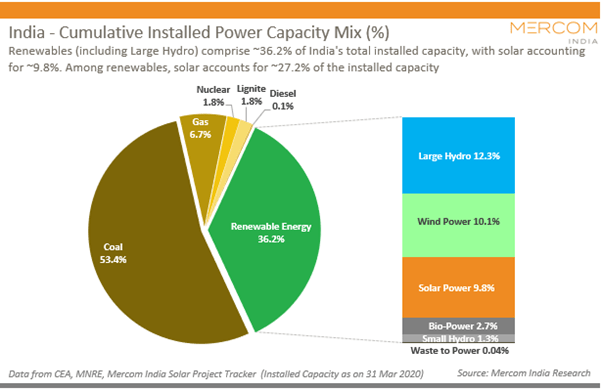
- Coal is by far the largest share of dirty fuels.
- Nationwide fossil fuels generate more than 70% of India’s electricity and have been doing so for decades.
- The Indian government has repeatedly defended its use of coal and its energy transition strategy, stating that the fuel is necessary for the nation’s energy security.
- In 2021, India announced its biggest-ever auction for coal mines inviting bids for 141 mines spread across 12 states in the country
- It will contribute to its target of producing 1 billion tons of coal by April 2024.
- From 2001 to 2021, India installed 168 gigawatts of coal-fired generation, nearly double what it added in solar and wind power combined, as per Ember data.
- Coal India limited, a government-owned company, is the largest state-owned coal producer in the world.
- It is responsible for about 82% of the total coal produced in India.
- The country’s coal-fired power plants have an average age of 13 years and India has 91,000 MW of new proposed coal capacity in the works, second only to China
- According to the Draft National Electricity Plan 2022, coal’s share in the electricity generation mix will decrease to 50% by 2030, compared to the current contribution of 70%
Status of Renewable energy
- Contribution It currently contributes about 10% of India’s electricity needs.
- Price of renewable energy has plummeted.
- The cost of solar power has dropped roughly sixfold from 12 rupees (14 cents) per kilowatt-hour in 2011 to 2.5 rupees (0.03 cents) per kilowatt-hour.
- Economic savings The planned buildout of 76 GW of solar and wind power by 2025 will avoid the use of almost 78 million tons of coal annually and could lead to savings of up to 1.6 trillion rupees ($19.5 billion) per year.
- Gujarat
- Coal’s share in producing electricity for Gujarat fell from 85% to 56% in the last six years, according to analysis by London-based energy think tank Ember
- The share of renewable energy for Gujarat grew from 9% to 28% in the same period.
- Gujarat is one of four of India’s 28 states that met their renewable energy targets for 2022.
- Other states Most states have installed less than 50% of their targets and some states such as West Bengal have installed only 10% of their target.
Challenges in transition
- Reducing the share of coal in the electricity generation mix is particularly acute because the sector is growing rapidly
- Development goals India’s quickly developing economy and growing electricity consumption per capita is causing rising demand
- Historically, countries that have achieved substantial and rapid transitions away from coal-fired power tend to have had either slowly growing or stagnant or even slightly declining electricity demand
- Growing demand India’s federal power ministry estimates that its electricity demand will grow up to 6% every year for the next decade.
- Acquiring land for clean energy projects in tough due to resistance from local communities.
- While longstanding contracts with coal plants also make it easier for state-run electricity companies to buy coal power instead of clean power.
- Inefficiency of DISCOMS As of December 2022, Indian state-owned electricity distribution companies owed power generators $3.32 billion in overdue payments.
- Their poor financial health has dampened their ability to invest in clean energy projects
- Skewed Lending scenario 60% of lending to the mining sector was for oil and gas extraction, while one-fifth of manufacturing sector debt is for petroleum refining and related industries.
- High-carbon industries — power generation, chemicals, iron and steel, and aviation — account for 10% of outstanding debt to Indian financial institutions. However, these industries are also heavily indebted, and therefore have less financial capacity to respond to shocks and stresses.
Suggestions for future:
- Planning It is great that India has a 2070 net zero target, but changes need to happen now for us to achieve this.
- Building renewables capacity and energy storage– electricity distribution companies need to allow for more rooftop solar installations even if it results in short-term economic losses for them.
- Investing in modernizing and building new wind energy projects will also speed up the transition.
- India needs $223 billion to meet 2030 renewable capacity goals
- Enacting more progressive policies — such as the $2.6 billion government scheme that encourages making components required to produce solar energy — and ensuring these policies are being implemented is essential to speed up a move toward renewables
- New laws such as the energy conservation bill as well as updated mandates issued by the federal government that make it necessary for electricity companies to purchase renewables provide hope
- Investment in new technology such as clean fuels like green hydrogen may improve battery storage for renewables to provide uninterrupted electricity
- Sovereign green bonds India is expected to launch its first-ever sovereign green bonds auction, with the Reserve Bank of India
Way forward
- A report by the Global Energy Monitor ranks India among the top seven countries globally for prospective renewable power.
- At the end of the day what is needed is speeding up the installation of renewables and associated infrastructure
- Ultimately in India, renewable energy is a highly cost-effective technology. The perception that coal is cheap is changing
Source: Indian express
Baba’s Explainer – India’s UPI Push
Syllabus
- GS-3: Indian Economy and issues relating to planning, mobilization, of resources, growth, development and employment.
- GS-3: Science & Technology
Context: On January 10, the National Payments Corporation of India (NPCI) paved the way for international (phone) numbers to be able to transact using UPI.
- A day later, the Union Cabinet chaired by Prime Minister Narendra Modi approved an incentive scheme for promotion of RuPay debit Cards and low-value BHIM-UPI transactions (person-to-merchant) in FY 2022-23. The scheme has an outlay of Rs 2,600 crore.
- These measures could prove significant for the UPI-based payment ecosystem which has largely witnessed a sequential rise in the previous calendar year.
Read Complete Details on India’s UPI Push
Practice MCQs
Q.1) With reference to ‘Kelp forests’, consider the following statements
- Kelp forests are large brown plants that regulate the underwater ecosystem.
- Kelp can be used as binding agents in cosmetic products.
Which of the statements given above are correct?
- 1 Only
- 2 Only
- Both 1 and 2
- Neither 1 nor 2
Q.2) An ‘Eklavya Model Residential School’ is responsibility of which of the following?
- Ministry of Tribal Affairs
- Ministry of Education
- NITI Aayog
- PM-STIAC
Q.3) Consider the following:
- Proso
- Foxtail
- Ragi
- Kodo millet
Which of the above are examples of Minor Millets?
- 1 2 and 3 only
- 2 3 and 4 only
- 1 2 and 4 only
- All of the above
Comment the answers to the above questions in the comment section below!!
ANSWERS FOR ’ 27th January 2023 – Daily Practice MCQs’ will be updated along with tomorrow’s Daily Current Affairs.st
ANSWERS FOR 26th January – Daily Practice MCQs
Q.1) – c
Q.2) – b
Q.3) – b













